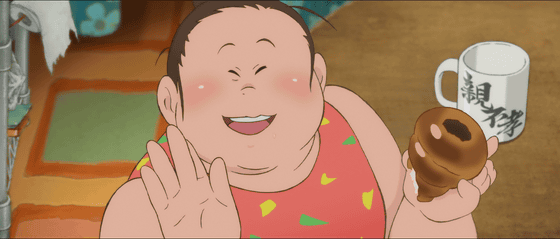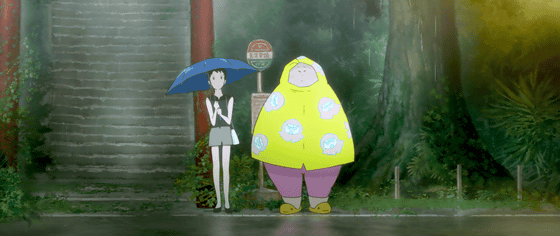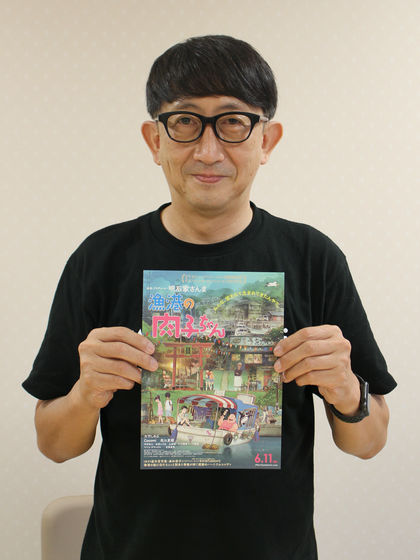Interview with Ayumu Watanabe, director of the anime movie 'Fishing Port Meatko-chan', Meiko-chan dares to become a manga-like and fantasy existence

'
I had the opportunity to talk to the main staff about how this work was realized, so I asked various questions about the work, work, staff, and so on. First is an interview with director Ayumu Watanabe.
The official website of the theatrical anime movie 'Fishing Port Meat Child'
https://29kochanmovie.com/
GIGAZINE (G):
According to the official Twitter account, pacific saury Akashiya was addicted to the work and offered to make it into an animated movie of 'Fishing Port Meat Child'. Did you come?
⛵️ About making an animation movie This is a comment from Mr. Sanma Akashiya, who was the planner and producer of this work!
— Theatrical anime movie “Fishing Port Meat Child” Official (@ 29kochanmovie) January 3, 2021
???? ️ #Immediately after Kanako Nishi received the direct award, there was a 'Saraba!' In the bookstore, and when I flipped through the book ... #Nikuko-chan at the fishing port ??? ? Continued pic.twitter.com/79pXARWZqB
During Egypt, it was written that he knew the main words 'cute', 'profitable', and 'Sanma Akashiya', so this is the story of ' #Sanma Akashiya'. I thought, I bought it and read it, but only one of them came out. (Laughs) #Nikuko from the fishing port continues
— Theatrical anime movie “Fishing Port Meat Child” Official (@ 29kochanmovie) January 3, 2021
After that, I read some of Mr. Nishi's works, and I met '#Nikuko-chan at the fishing port ' there.
— Theatrical anime movie “Fishing Port Meat Child” Official (@ 29kochanmovie) January 3, 2021
It's a coincidence. The use of Hanben is messed up.
Continue
' # Nikuko-chan of the fishing port ' is very good because it is emotional work (almost) Tokoro⻄ who was the offer of imaging is us to immediately OK.
— Theatrical anime movie “Fishing Port Meat Child” Official (@ 29kochanmovie) January 3, 2021
It was finally realized after waiting for about 5 years since I first talked about it.
This animation movie is a product of energy. Please stay tuned! #Akashiya pacific saury
Director Ayumu Watanabe (hereinafter referred to as Watanabe):
I think it was about two and a half years or three years ago. It seems that he was originally thinking of making it into a live-action film, and he got permission to make it into a live-action film, but he said that it was difficult to decide on casting. Especially meat child. Besides, if you decide on a specific person, the image will be solidified, so I said, 'Let's make a picture.' I think that the story came to STUDIO 4 ℃, which had a deal with Mr. Yoshimoto when making the animation.
G:
What was your impression when you first heard that Director Watanabe would make 'Nikuko-chan in the fishing port' into an anime movie?
Watanabe:
I was scared to hear the title (laughs). I knew the title itself, but I didn't read it ... but I didn't like it. When I read it, I was drawn in, saying, 'This may be really interesting.'
G:
Looking at the making video released on official Twitter, you can see that pacific saury-san and Director Watanabe are actively communicating, and pacific saury-san is not just putting his name on the front. At the scene, how did you get the idea that 'pacific saury-san's attempt to make'Nikuko-chan at the fishing port'is like this'?
☀ As expected, Mr. Shimono ????!
— Theatrical anime movie “Fishing Port Meat Child” Official (@ 29kochanmovie) March 29, 2021
Respond quickly to sudden ikemen (good-looking voice) requests ???? ✨ Please also see the making video that contains the exchange between #Hiroshi Shimono and #Sanma Akashiya ???? #Nikuko- chan at the fishing port ⛵ @ shimono_kousiki pic.twitter.com/XXuOvX5981
Watanabe:
Mr. pacific saury was present from the meeting of the first composition, and there was a talk about 'what kind of things do you want to see?' 'It's not about targeting and marketing. It's important that the creator is interesting.' 'We'll send you something interesting, because the original story isn't right, so if you take care of it and make it.' Mr. pacific saury is a very service-minded person, and I felt that he wanted to entertain him.
Looking back on the production ???? ️ #Director Ayumu Watanabe 'When someone talked about the concept and marketing, Sanma said,' That's not true. It's important that the creator is interesting. I think it's a good story. You should take care of that and make it. ”I felt that you were thinking about making the most of the performers first.” #Nikuko-chan at the fishing port pic.twitter.com/nzafwOfPsR
— Theatrical anime movie “Fishing Port Meat Child” Official (@ 29kochanmovie) May 27, 2021
G:
So that's it.
Watanabe:
Even in terms of composition, it is not possible to include all of the novels due to the scale, so I chose the story, but pacific saury-san roughly said, 'This is how you inflate here, and at the end it looks like this.' I decided the image and made it based on it. I think it's a work with a high degree of 'pacific saury purity' (laughs)
G:
(Laughs) pacific saury-san said, 'The important thing is that the creator is interesting.' What does 'the creator think is interesting' for the director?
#Comments from director Ayumu Watanabe have arrived ???? #I'm glad that Sanma Akashiya gave me a chance to animate. pacific saury-san will give you 'awareness' every time we have a meeting. 'The big thing is that the maker thinks that he is a woman.' I always keep this leaf in my heart. #Nikuko-chan at the fishing port ???? Continued
— Theatrical anime movie “Fishing Port Meat Child” Official (@ 29kochanmovie) January 5, 2021
Watanabe:
There are things like creating a gag or a screen, but due to the composition, various hints are studded, and the excitement and the fun of noticing that will occur when collecting it, I think that this is also 'I'm glad to convey' I made it while doing it. Aiming for that, I think I was able to make one movie while sharing it with the staff.
G:
Mr. Kenichi Konishi, the chief animation director, commented, 'Because I made an animated movie, both the director and I had the desire to make our own character.' What does that mean?
About animating a novel that creates characters from scratch ???? ️
— Theatrical anime movie “Fishing Port Meat Child” Official (@ 29kochanmovie) June 6, 2021
Animation director #Kenichi Konishi 'Because I make an animated movie,
Both the director and I had the desire to create our own character.
It was a very thankful and important opportunity. #Nikuko- chan at the fishing port @ kenichi_0623 pic.twitter.com/hqNaUaP4A9
Watanabe:
In a work that already has a visual like the original manga, the character design will be made based on that, while the novel is not completely free, but it is not visual even though there are conditions. It's a place where it's fun to build things. I haven't had this kind of tension until now, so it may be a big deal to say 'challenge' (laughs). Character construction has a big element to the overall visual in making an animated work, so being able to do design work without the original picture is a big thing for our team, even if it is a small step. I think it was.
G:
Looking at the sample image of 'Nikuko-chan at the fishing port' ART BOOK , it seems that the image of Nikuko-chan and Kikuko has already been completed with the image with 'Initial rough sketch by Director Watanabe'. When was this design drawn?
Watanabe:
This is already the early days. I read the original and drew it with the intention of exploring an approach to the character before meeting pacific saury-san before the script was written.
G:
Did the image suddenly come out in this shape? Or was it the result of trial and error?
Watanabe:
On the contrary, I think that something close to the completed form came out at once. In the novel, there was a concrete analogy that the meat child was an 'Indian stray dog', so it is a pattern that I put in without leaking it. When I showed it to pacific saury-san, he said, 'Oh!', And he was very pleased that it became a picture. The reaction was 'Did you come this way!'
G:
Does the director say that these illustrations are in the style of being drawn in a sketch book?
Watanabe:
Okay. I draw it so that I don't forget the image. It's not very cohesive (laughs)
G:
Regarding this character, I saw the director's comment, 'In the end , I wanted to make a manga-like picture rather than a realistic visual.' What was the reason for thinking 'Let's make a manga-like picture'?
Watanabe:
Especially for Nikuko-chan, I thought it would be nice to have a fantasy feeling, like a forest fairy (laughs).
G:
Fairy (laughs)
Watanabe:
Something like being separated from humans. That's why I decided to go with it because it's a picture. Normally, the character design should be unified, and most characters are set within a certain range along one direction, but this time I stopped it and only one person is strangely simple. I made it. I was told, 'The design without shadows is ...', so I added shadows (laughs), but I thought it was something out of the ordinary. 'Isn't it okay if such an anime is established?' Somehow, the story of a masterpiece homage was a little ahead, but rather from there.

G:
(Lol)
Watanabe:
That wasn't the purpose from the beginning, but I wish I could handle it just like that. As an animation technique, it's a little too free and it's supposed to be ridiculous (laugh)
G:
That was exactly the masterpiece homage, 'Totoro!' When the scene photo was completely released (laughs). How did this scene come about?
Watanabe:
It happened that the conditions were met. Parents and children are waiting for the bus at the bus stop in the rain. When I made it into a picture, he said, 'That !? I've seen it. This déjà vu ... Totoro-yan!' (Laughs). I didn't think 'let's make it look like Totoro' from the beginning, but it was similar when the elements were arranged. If you look at this, I wonder if it's so similar ... Is it similar (laughs)
G:
It's similar (laughs)

Watanabe:
This means, 'Nikuko-chan is a fantasy.' Even for small children, it is an image that enhances the affinity, saying, 'Auntie is like Totoro.' It is also a sign of the determination to overcome it with respect. ...... I'm likely to get angry (laughs). I was really thrilled when this image preceded. It's true that I'm feeling weird palpitations, even though I hope the viewer thinks 'maybe'. Originally it is better to do it secretly (laugh)
G:
Before releasing the work, 'Please let me have a bag! There
Watanabe:
The actual size and the bounce atmosphere of the ball. If you search for movements, you will see a video, but there are some parts that you can't understand without touching them, so don't leave it to your imagination and let the feeling of touching be important. Also, I can lie by making a picture, but I have to do it based on the true texture. I didn't have to bother to stick to the enamel basin (laughs), but that would make the meat look more delicious. It may be too detailed detail, but I think that various lies can be established not only by imagining what it will look like when Nikuko holds it, but also by holding down the real thing exactly. I think it would be better if there was a real backing in order to make a lie.
G:
Mr. Konishi commented on the director on Twitter and tweeted that he is a person who likes guitar, keyboards, and multiplayer. Why can you play so many things?
Director Watanabe is also a fan of guitar, keyboards, and multiplayer. Did you perform a solo performance of the ukulele at an old party ???? If you have the next one, let's request it ~ #Children of the Sea #Director Ayumu Watanabe #Anime Style #Loft Plus One https://t.co/ lsIkyJipQ0
— Kenichi Konishi (@ kenichi_0623) February 1, 2020
Watanabe:
It's just fun (laughs). This is also connected to the previous answer, but I started with the idea of 'I want to see the real thing.' I will try to hit the real thing for the time being. Try to touch what you touch. It feels like the numbers and types have expanded from there.
G:
What is the effect of seeing and knowing the real thing on the part of the creator? Is it something that can be understood from the viewer?
Watanabe:
It's just a small part of the weight when you lift it. With a guitar, depending on how you put it on your shoulder and the angle at which you put it on your body, there are times when you can take a pose that you should actually hold rather than leave it to your imagination. And I notice places that are often overlooked. For example, the angle of a hand holding a mobile phone is unexpectedly difficult, and people who can imagine it are amazing. This is the part that you have to do properly, and it appears in the small parts of poses and movements.
G:
What kind of person is Kenichi Konishi, the chief animation director, from the perspective of director Watanabe?
Watanabe:
He is a person who does not compromise on all of these textures. If you say 'there is a high compromise', you will end up with 'will you compromise?', So I wonder if it will be 'the way you train differently' (laughs). I mean they have different ambitions. Someone who thinks 'I might get better if I stick a little more', and even if it's OK, I stick to 'Let's try a little more'. I would give OK if the cut was established and the direction was correct, but ... I'm a ridiculous person (laughs)
G:
This time, I have the opportunity to talk to Shinji Kimura of art. What kind of person is Mr. Kimura from the perspective of Director Watanabe? I feel that this work is very art-oriented.
Watanabe:
This person is also an uncompromising person (laughs). From my point of view, there are some cuts that I would like people to enjoy in terms of pace distribution, but I feel that they are really stoic because they fill in those cuts. Everything you draw has meaning. People's breath, personality, situation ... Imagine everything and weave it into the background. It may not be the background work anymore. It's more than just a 'scenery' ... Like Mr. Konishi, the amount of heat applied to one cut and one shot is always at full throttle, and he is a really amazing person. Perhaps he is the person who directs the most in the screen composition (laugh)
G:
(Lol)
Watanabe:
Since all of these people are there, it's a ridiculously good work. I think I can have more fun (laughs). However, it is a fact that the dignity of the work is getting higher thanks to it.
G:
In what kind of scene do you feel the stoicism of the two people?
Watanabe:
It can be said that every scene is amazing, but is it still a hospital room scene? It's difficult to say, but it feels like 'I'm drawing things that I don't have to draw.'
G:
Oh…….
Watanabe:
I've drawn up to the edge of the screen, 'I wish there was something else', so please pay attention to it.
G:
What do you do when the director finds such 'drawing things that you don't have to draw'?
Watanabe:
While saying 'I don't have to draw', I said 'Shimeme' (laughs)
G:
(Lol)
Watanabe:
'It's okay if you don't have it, but did you do it!' The play was uncompromising and it was amazing. What this work is drawing is very natural, 'only the aunt is talking' (laugh), but it is thanks to the two people that we were able to firmly infiltrate the drama there. We appreciate.
G:
Does it feel like you're getting more than you expected?
Watanabe:
The scene in the hospital room is, so to speak, a 'scene where you can enjoy yourself'. However, I think it's difficult for me to draw it so well.
G:
Finally, please give us a word that pushes the back of those who are wondering whether to go to see this work.
Watanabe:
Nikuko herself is a very fantasy existence, and although it has a manga-like part, it has a solid depiction that allows it to exist. In the animation, I hope that you can enjoy the possibility that it is okay to live together, the comfortable discomfort due to the high degree of freedom, the enjoyment of acting that is too free, and the warm story by Kanako Nishi. I will.

G:
Thank you for today.
The movie 'Fishing Port Meat Child' is showing a big hit.
After this, we will also post an interview with Kenichi Konishi, the chief animation director, and Shinji Kimura, the art director. Please look forward to what kind of two people the director said 'do not compromise'.
・ Continued
What is the intention of the layout correction in the interview with Kenichi Konishi, the chief animation director of 'Nikuko-chan at the fishing port'? --GIGAZINE

Related Posts:






